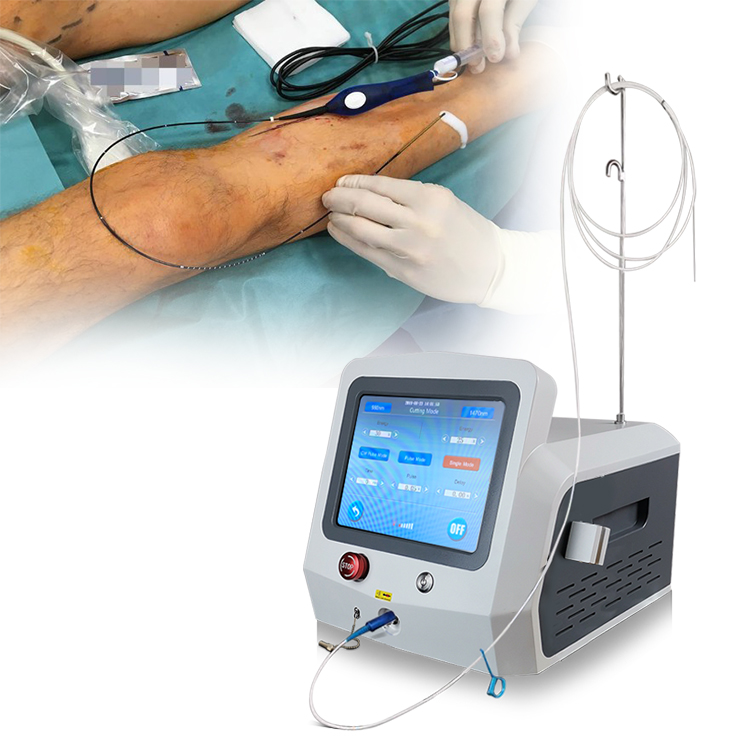1470Nm laser is a new type of semiconductor laser. It has the advantages of other laser that cannot be replaced. Its energy skills can be absorbed by hemoglobin and can be absorbed by cells. In a small group, rapid gasification decomposes the organization, with small heat damage, and has the advantages of solidifying and stopping bleeding.
1470nm wavelength is preferentially absorbed by water 40 times more than a 980-nm wavelength, the 1470nm laser will minimize any post-operative pain and bruising and the patients will recover quickly and back to daily work in short time.
The feature of 1470nm wavelength:
The New 1470nm semiconductor laser scatters less light in the tissue and distributes it evenly and effectively. It has a strong tissue absorption rate and a shallow penetration depth(2-3mm). The coagulation range is concentrated and will not damage the surrounding healthy tissue. Its energy can be absorbed by hemoglobin as well as cellular water,which is most suitable for the repair of nerves,blood vessels,skin and other tiny tissues.
1470nm can be used for vaginal tightening, facial wrinkles, and can also be used for nerves,Vascular, skin and other micro -organizations and tumor resection, surgery, and EVLT,PLDD and other minimally invasive surgery.
Will first introduce the 1470nm laser for Varicouse veins:
Endovenous laser ablation (EVLA) is one of the most accepted treatment options for varicose veins.
Advantages of Endovenous Ablation in Treating Varicose Vein
- Endovenous Ablation is less invasive, but the result is same as open surgery.
- Minimal pain, does not require general anaesthesia.
- Fast recovery, hospitalization is not a must.
- Can be performed as a clinic procedure under local anaesthesia.
- Cosmetically better because of needle size wound.
What is Endovenous Laser?
Endovenous Laser therapy is a minimally invasive treatment alternative to the traditional vein stripping surgery for varicose veins and gives better cosmetic results with less scarring. The principle is that by removing the abnormal vein by applying laser energy inside the vein (‘endovenous’) to destroy (‘ablate’) it.
How is EVLT done?
The procedure is performed on an outpatient basis with the patient awake. The entire procedure is done under ultrasound visualisation. After a local anaesthetic is injected into the thigh area, the laser fibre is threaded into the vein through a small puncture hole. Then laser energy is released which heats up the wall of vein and causes it to collapse. Laser energy is released continuously as the fibre moves along the whole length of the diseased vein, resulting in the collapse and ablation of the varicose vein. Following the procedure, a bandage is placed over the entry site, and additional compression is applied. Patients are then encouraged to walk and resume all normal activities
How is EVLT of varicose vein different from conventional surgery?
EVLT does not require general anaesthesia and is a less invasive procedure than vein stripping. The recovery period is also shorter than surgery. Patients usually have less post-operative pain, less bruising, faster recovery, fewer overall complications and smaller scars.
How soon after EVLT can I return to normal activity?
Walking immediately following the procedure is encouraged and normal daily activity can be resumed immediately. For those into sports and heavy lifting, a delay of 5-7 days is recommended.
What are the key benefits of EVLT?
EVLT can be performed entirely under local anaesthesia in most cases. It is applicable to the majority of patients including those with pre-existing medical conditions or medications preventing the administration of a general anaesthetic. Cosmetic outcomes from laser are far superior to stripping. Patients report minimal bruising, swelling or pain following the procedure. Many return to normal activities immediately.
Is EVLT suitable for all varicose veins?
The majority of varicose vein can be treated with EVLT. However, the procedure is mainly for large varicose veins. It is not suitable for veins which are too small or too tortuous, or with an atypical anatomy.
Suitable for:
Great Saphenous Vein (GSV)
Small Saphenous Vein (SSV)
Their major tributaries such as the Anterior Accessory Saphenous Veins (AASV)
If you want to know more about our machine, please contact us. Thanks.
Post time: Nov-07-2022

